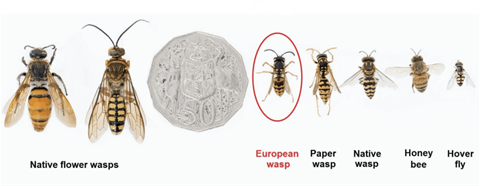There is a buzz in the air - Australian and European Wasps
Published on 26 April 2023

Australian native wasps
Did you know there are over 12,000 species of wasps in Australia? Native Australian wasps range in size from being so tiny they’re barely visible, to larger and capable of taking large prey such as cicadas and spiders. Wasps are fascinating animals, but this group of insects often gets a bad rap due to the aggressive nature of the introduced European wasps.
One of the main benefits of Australian native wasps is their role as pollinators. Just like bees, wasps play an important role in transferring pollen from one flower to another, which allows plants to reproduce. Without wasps, many plant species would struggle to survive, and we would see a decline in biodiversity across our landscapes.
Another benefit is their ability to control pest populations. Some species of native wasps are predators or parasitoids of other insects, meaning they hunt and kill pests that can damage crops or gardens. This natural form of pest control is an environmentally friendly alternative to using harmful chemicals.
European Wasps
While the onset of the cooler weather has started to subdue the behaviour of certain animals, this is not the case with European wasps. They are most active during the late summer and early autumn months, typically from February to May.
The Victorian Department of Health created this helpful resource which provides a wealth of information on European wasps, including tips to discourage them and eliminate their nest, and how to effectively identify them to avoid mistakenly harming the native wildlife that we all love and depend on.
The eWasp website and app helps identify some of the more common problematic insects (including the European wasp) and how to tell them apart from beneficial native Australian insects. Wild Pollinator Count also has some great tips (and posters) to help you identify pollinator insects.
European wasps are very aggressive and can sting multiple times, unlike bees. Contact a licensed pest controller to remove the nest and always wear protective clothing if you attempt to approach their nest.
So next time you see a wasp buzzing around, try to determine (from a safe distance) if it is an introduced European wasp, or an Australian native species. And if you're lucky enough to spot an Australian native wasp, take a moment to appreciate the important role it plays in our environment and know that you're witnessing one of nature's unsung heroes.